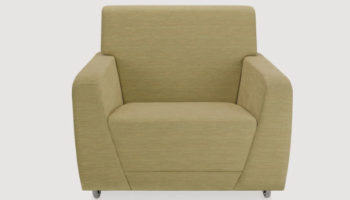Vladimir Kagan Couture: Omnibus Back-to-Back
The transition from small, framed artwork to wall-to-wall paintings instigated a new philosophy of design. Freestanding pieces, pulled away from outer walls, began to provide paintings with breathing room – and seating from which to view the work. Vladmir Kagan‘s legendary serpentine exemplifies this trend, taking on the form of a sculpture. Kagan has been developing these solutions for clients including Gary Cooper, Marilyn Monroe, Barry Diller, Tom Ford and Angelina Jolie since the Fifties.
Omnibus Back-to-Back. Designed by Vladmir Kagan.
Kagan, the mastermind behind free-forms seating, has been described by the New York Times as “one of the most important furniture designers of the 20th century. Furniture designed by him in the forties, fifties and sixties have become icons of Modernity and an obligatory reference to every designer.” His Omnibus Sofa, first introduced in the late 1960s, became one of the hallmarks of Kagan’s career. Omnibus Back-to-Back is sofa and bed variation on this classic piece, a revival of the design. The epitomy of versatility, it consists of a flat upholstered ‘bed’ with flexible L-shaped cushions that can be easily repositioned to create various sleeping and seating congurations. In Tom Ford’s redesign of Gucci stores, he consulted Kagan to create a range of the Omnibus sofa variation. 360 Gucci stores throughout the world were outfitted with this iconic classic.


In an interview with LuxuryCulture in 2005, the designer, now in his eighties, explained how he was influenced by early collectors of his work. “In the Fifties my clients were largely people who collected modern paintings by artists such as Hans Hoffman and Jackson Pollack. They had these huge wall-to-wall paintings and no room for furniture.” Kagan explains, “So I had to create walls for the paintings and move the furniture into the inner space so that you could look at the artwork. It created a whole new philosophy of design. I consider it to be 20th-century living, when, by contrast, paintings were confined to small frames. My clients have always stimulated my creativity because I had to come up with interesting solutions to interesting problems. They accepted my creativity as part of the artistic environment in which they wanted to live.”
His Serpentine Sofa (1952) sold for a record $192,000 at Christie’s in 2005. In 1987, he closed his factory and showroom with plans to retire. But due to great demand, he returned to the furniture world, designing exclusive custom furniture in addition to commercial furniture for manufacturers: ‘couture’ and ‘ready-to-wear’.




Leave a Reply